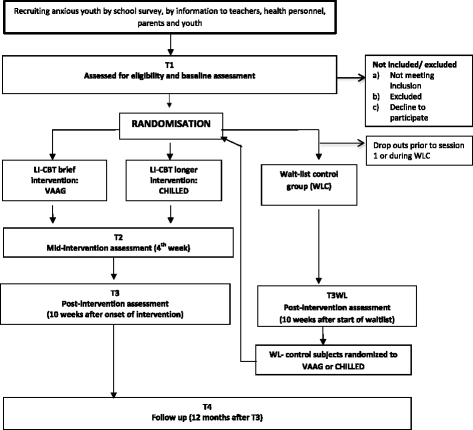School-based cognitive behavioral interventions for anxious youth: study protocol for a randomized controlled trial
- PMID: 28259171
- PMCID: PMC5336667
- DOI: 10.1186/s13063-017-1831-9
School-based cognitive behavioral interventions for anxious youth: study protocol for a randomized controlled trial
Abstract
Background: Anxiety disorders are prevalent among adolescents and may have long-lasting negative consequences for the individual, the family and society. Cognitive behavioral therapy (CBT) is an effective treatment. However, many anxious youth do not seek treatment. Low-intensity CBT in schools may improve access to evidence-based services. We aim to investigate the efficacy of two CBT youth anxiety programs with different intensities (i.e., number and length of sessions), both group-based and administered as early interventions in a school setting. The objectives of the study are to examine the effects of school-based interventions for youth anxiety and to determine whether a less intensive intervention is non-inferior to a more intensive intervention.
Methods/design: The present study is a randomized controlled trial comparing two CBT interventions to a waitlist control group. A total of 18 schools participate and we aim to recruit 323 adolescents (12-16 years). Youth who score above a cutoff on an anxiety symptom scale will be included in the study. School nurses recruit participants and deliver the interventions, with mental health workers as co-therapists and/or supervisors. Primary outcomes are level of anxiety symptoms and anxiety-related functional impairments. Secondary outcomes are level of depressive symptoms, quality of life and general psychosocial functioning. Non-inferiority between the two active interventions will be declared if a difference of 1.4 or less is found on the anxiety symptom measure post-intervention and a difference of 0.8 on the interference scale. Effects will be analyzed by mixed effect models, applying an intention to treat procedure.
Discussion: The present study extends previous research by comparing two programs with different intensity. A brief intervention, if effective, could more easily be subject to large-scale implementation in school health services.
Trial registration: ClinicalTrials.gov, NCT02279251 . Registered on 15 October 2014. Retrospectively registered.
Keywords: adolescents; anxiety; low-intensity CBT; school-based.
Similar articles
-
Adaptive School-based Implementation of CBT (ASIC): clustered-SMART for building an optimized adaptive implementation intervention to improve uptake of mental health interventions in schools.Implement Sci. 2018 Sep 5;13(1):119. doi: 10.1186/s13012-018-0808-8. Implement Sci. 2018. PMID: 30185192 Free PMC article. Clinical Trial.
-
Study protocol for a pragmatic randomised multiple baseline trial evaluating Knowledge Insight Tools (KIT), a cognitive behavioural therapy-informed school-based counselling intervention for children and young people in UK secondary schools with low mood and anxiety.Trials. 2024 Sep 30;25(1):637. doi: 10.1186/s13063-024-08299-z. Trials. 2024. PMID: 39350145 Free PMC article.
-
Effectiveness of Brief and Standard School-Based Cognitive-Behavioral Interventions for Adolescents With Anxiety: A Randomized Noninferiority Study.J Am Acad Child Adolesc Psychiatry. 2020 Apr;59(4):552-564.e2. doi: 10.1016/j.jaac.2019.12.003. Epub 2020 Jan 8. J Am Acad Child Adolesc Psychiatry. 2020. PMID: 31926224 Clinical Trial.
-
Cultural Adaptation and Implementation of Cognitive-Behavioral Psychosocial Interventions for Anxiety and Depression in Japanese Youth.Clin Child Fam Psychol Rev. 2023 Sep;26(3):727-750. doi: 10.1007/s10567-023-00446-3. Epub 2023 Jul 27. Clin Child Fam Psychol Rev. 2023. PMID: 37500948 Review.
-
Evidence Base Update on the Treatment of Early Childhood Anxiety and Related Problems.J Clin Child Adolesc Psychol. 2019 Jan-Feb;48(1):1-15. doi: 10.1080/15374416.2018.1534208. Epub 2019 Jan 14. J Clin Child Adolesc Psychol. 2019. PMID: 30640522 Review.
Cited by
-
Commentary: Evaluating Delivery of a CBT-Based Group Intervention for Schoolchildren With Emotional Problems: Examining the Reliability and Applicability of a Video-Based Adherence and Competence Measure.Front Psychol. 2021 Sep 27;12:737095. doi: 10.3389/fpsyg.2021.737095. eCollection 2021. Front Psychol. 2021. PMID: 34646218 Free PMC article. No abstract available.
-
Social frames promoting sharing in Norwegian Recovery Colleges: an ethnographic study.Front Psychiatry. 2025 Jun 23;16:1606180. doi: 10.3389/fpsyt.2025.1606180. eCollection 2025. Front Psychiatry. 2025. PMID: 40625722 Free PMC article.
-
Zoom-based GROW coaching intervention for improving subjective well-being in a sample of school administrators: A randomized control trial.Internet Interv. 2022 May 26;29:100549. doi: 10.1016/j.invent.2022.100549. eCollection 2022 Sep. Internet Interv. 2022. PMID: 36092992 Free PMC article.
-
Internalizing Symptom Profiles Among Youth in Foster Care: A Comparison Study.Front Psychiatry. 2021 Aug 16;12:711626. doi: 10.3389/fpsyt.2021.711626. eCollection 2021. Front Psychiatry. 2021. PMID: 34489762 Free PMC article.
-
Sleep Duration and Insomnia in Adolescents Seeking Treatment for Anxiety in Primary Health Care.Front Psychol. 2021 Mar 24;12:638879. doi: 10.3389/fpsyg.2021.638879. eCollection 2021. Front Psychol. 2021. PMID: 33841272 Free PMC article.
References
-
- Mykletun A, Overland S, Dahl AA, Krokstad S, Bjerkeset O, Glozier N, Aaro LE, Prince M. A population-based cohort study of the effect of common mental disorders on disability pension awards. Am J Psychiatry. 2006;163:1412–8. - PubMed
Publication types
MeSH terms
Associated data
LinkOut - more resources
Full Text Sources
Other Literature Sources
Medical


